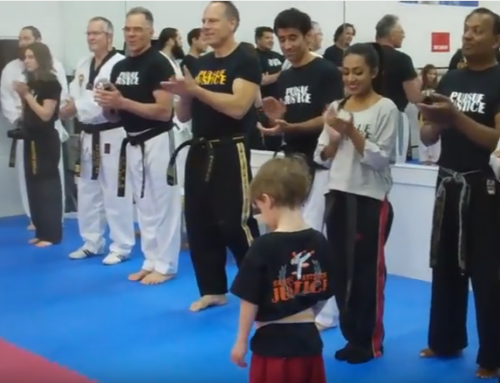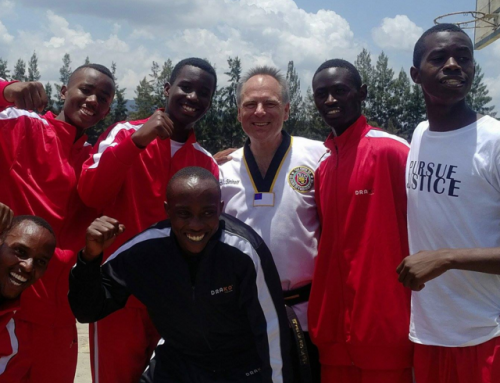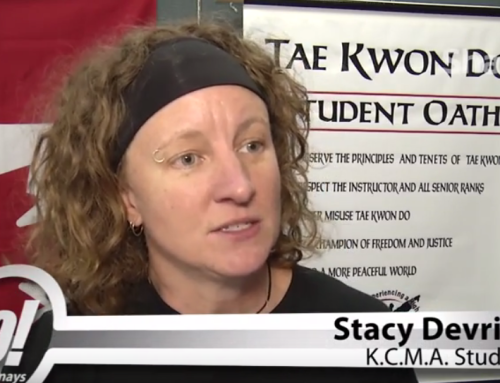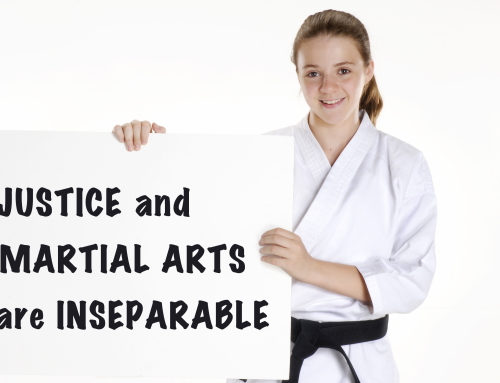In 1994, I walked into a Dojang for the first time. I was thirty-five years young then. It still comes back to me clearly…all the NEW things to learn. It was like learning a new way to speak: Korean meanings for the commands and new etiquette like bowing before you enter the room and bowing to your instructor and classmates. Do YOU remember the first time that you put on a white belt? Did it take courage to walk into a strange place and start to learn a discipline that you knew nothing about? What were your expectations then and what are they now? I always remember being so intimidating at my first gold belt test, which makes me smile now from the vantage point of a 5th Dan Black Belt.
The student oath and tenets hung on scrolls at the front of the room, very prominently so that you could not miss them. I would go on to repeat these tenets and other versions of them more than once a week for the next twenty years. Whether it’s Taekwondo, Karate or other martial arts disciplines, most of the student oaths, tenets and creeds include similar themes and meanings. The best way that I would summarize them would be “right living” – doing what is right by yourself and others, and interestingly, that is the definition of justice. The www.iep.ut.edu/justwest/ website says, “Justice is one of the most important moral and political concepts. The word comes from the Latin jus, meaning right or law. The Oxford English Dictionary defines the ‘just’ person as one who typically ‘does what is morally right’ and is disposed to ‘giving everyone his or her due,’ offering the word ‘fair’ as a synonym.”
Would you not agree this is the essence of how a martial artist should live his or her life? While most of us would have joined a martial art primarily for physical fitness, we all agree there must be a balance between mind, body and spirit for us to be healthy individuals. Our goal is to not only build a strong body, but also strong character and spirit, but then for what purpose? In the pursuit of justice, as an instructor, are you teaching your students what this means and are you living it out for them to see or considered giving them opportunities to live this out in big ways?
I know without a doubt that your martial arts school and 98% of others in North America are doing great work in their communities and for their students. Developing a student into a black belt is no small thing. This student, regardless of whether they stop training after receiving a black belt, will go on in life with a better chance of being a solid citizen because of their training and all that you invested in them. I believe most martial artists would agree that we should not limit ourselves or our students in what we are capable of doing to impact our communities and our world.
I had a desire gnawing at me for quite some time and felt there was more I should be doing beyond our school and community, but I could not put my finger on it, until one day a conversation with a good friend changed everything. My friend, Stacy, introduced me to the work of International Justice Mission who is a global NGO focused on preventing violence against the poor, including rescuing children from horrors like sex trafficking. IJM estimates there are 36 million people in the world today in some form of slavery. As a martial artist, I have to tell you I felt called to action like never before. If we as martial artists globally are not on the front lines combating this, there is something wrong.
As Stacy and I discussed what could be done, we decided that raising money was the best way at the time to support the work of IJM and I proposed our first “break-a-thon” in Nelson that year. We booked our local shopping mall as the venue where we would hold the breaking event to engage the public and to add to the excitement for the students. We created pledge forms and students were encouraged to go out and raise what money they could and they would be given boards to break dependent on their funds raised. All ages were involved and the excitement was contagious throughout the whole school as friends, parents and family members were also invited to attend and the local media covered us enthusiastically. The next couple years we invited other schools to join us and now our Breaking Boards Breaking Chains event has become a national fund raising campaign through Martial Arts for Justice, continuing to support the work of IJM.
While supporting the work and learning more about IJM, my wife and I had the opportunity to travel to the neighboring countries of Uganda and Rwanda last May. There are many similarities in their moderate climates and rolling hills. I was intrigued about what we would learn and discover there and I was surprised how little the more than sixteen hours of flying time affected me. One of many scenic memories was the stunning sunset over lake Victoria while flying south to Rwanda. To me, Africa held so much mystery and it is a continent that has had more than its share of struggles. What we did learn while there is that the people have an unusual depth and openness to them, perhaps due to their lives of hardship. For many of the people there, the only difference between them and me is that they lack opportunity and a functioning justice system. It did not take long to make deep connections that I believe will last a lifetime. It was a privilege to witness firsthand the fantastic work being done by IJM and to look “under the hood” of their field offices. I can say without a doubt that they are doing incredible work in very tough areas for people who are living without the benefit of a functioning justice system. Imagine you or your family not being able to call 9-1-1 in an emergency. That is what it is like for millions of the world’s poor.
Supporting the work of IJM is the next best thing to us being there. While in Africa, I met many precious kids, youth and adults that I felt could benefit greatly from martial arts training so this year MAJ is now developing the concept of “sister schools,” where martial arts schools here in North America will support the startup of martial arts and provide ongoing support for schools in poor communities around the world. There was a Stanford University study done in Kenya that showed a significant decrease in violence for girls after being taught some self-defense and life skills.
“In the 10 months after receiving self-defense training, more than half of these girls reported using what they had learned to fend off would-be attackers. The proportion of them who were raped fell from 24.6 percent in the year before training to 9.2 percent in the 10-month period after.”
Martial artists have the greatest capacity to eliminate this problem of violence against the poor and vulnerable. Government estimates say there are over 70 million people that practice Taekwondo and more than 50 million that practice Karate worldwide. That is a massive force that, once mobilized for the cause of justice, could not be stopped. In whatever style of martial art you practice, we should excel and enjoy the sporting part of our training, but not neglect the more important components of training our character that leads to the pursuit of justice through martial arts!






Magnificent site. Lots of useful information here.
I am sending it to several buddies ans also sharing in delicious.
And of course, thank youu for your sweat!
Hi Lyanna,
Thank you for your comment. It’s great to hear your feedback on our new site. We look forward to hearing from you again and hope that you will be able to participate in our break-a-thon this year. Please connect with us on social media and feel free to email us anytime with your contact us anytime. We always enjoy hearing form our supporters.